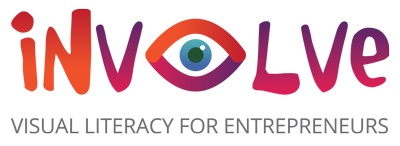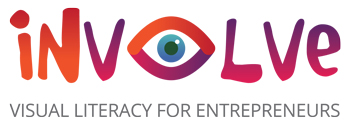Introduction to “Integrating Visual Literacy Teaching into Adult Entrepreneurship Education” INVOLVE
Entrepreneurship education occupies a key role in the Europe 2020 strategy for growth and jobs. Today’s business environment is very visually oriented. Instagram, social media, tiktok and advertising etc – all image-rich disciplines – have become almost ubiquitous. The NEED for entrepreneurs to be visually literate in this technological age was never greater.
In addition, it is also widely accepted that many people with low level of skills and especially people with Intellectual Disability (ID) do best in learning environments where visual teaching aids are used. Yet, paradoxically and worryingly, visual skills are almost entirely absent from entrepreneurship curricula across the adult education sector.
Hence, the objective of our project is clear: strengthen the visual literacy of entrepreneurs by introducing innovative visual literacy training into adult entrepreneurship education curriculum and courses
By introducing visual literacy training into adult education, the project addresses the following priorities:
ACCESS to UPSKILLING PATHWAYS
Entrepreneurship has been defined by the EU as a key competence since 2006 and the 2016 Entrepreneurship Competence Framework (EntreComp) consolidates it as a transversal competence that contributes to all aspects of personal, civic and professional development. Traditional ‘start a business’ enterprise courses have multiplied in recent years, as has the range of training available on technical/operational aspects of business growth: finance, employment, exporting etc. The INVOLVE model, however, will enable learners to develop more visual entrepreneurship skills, particularly suitable for early stage entrepreneurs.
The skills embedded in the INVOLVE model and taught through classroom teaching toolkit (IO2) and self-led learning (online course, IO3) relate directly to the Entre Comp competence, “1.2 Creativity: Develop creative and purposeful ideas and 1.3 Vision: Work towards your vision of the future.” As such, participating in INVOLVE training will not only support individuals in being able to identify and respond to ideas and opportunities, it will make a marked contribution to strengthening their overall entrepreneurial mindset and their ability to adapt to a fast-changing world.
Our Second (and Third) priority, is to SUPPORT EDUCATORS, and in particular EXTEND AND DEVELOP THE COMPETENCES OF EDUCATORS in the field of DIGITAL & VISUAL LEARNING. Policy and research documents are very clear on this point: one of the principal drivers which enables digital innovation to have a meaningful effect on learning are the skills of the educators themselves (EC, Adult Learners in Digital Learning Environments, 2015) and that digital learning is “most effective and sustainable when embraced by welltrained teachers and embedded in clear teaching goals. More needs to be done on how to best use digital means to reach education objectives.” (EC, Communication on the Digital Action Plan, 2018).
The project adopts a clear “educate the educator” approach, and recognizes that the barriers that adult education teachers and trainers face are not only knowledge based, but also attitudinal/motivational and behavioural. All of our outputs will be focussed on helping teachers move further along the path to digital teaching confidence: the Good Practice Guide Book (IO1) is an introductory resource designed to raise awareness and make a strong case for “why” adult educators cannot afford to ignore visual and digital learning; subsequently the Toolkit (IO2) presents more detailed practical guidance on which tools are best suited to different pedagogical strategies and competence areas.
We are particularly cognizant of the opportunity to develop our resources in a way that reflects the competence structure of the European Framework for the Digital Competence of Educators (Dig Comp Edu), the Digitally Competent Educational Organisations (Dig Comp Org) and where possible the SELFIE tool (as it should be adapted from a school setting.)
Doing so will both help teachers and trainers understand the value of investing time in developing their visual teaching competences and ensure the relevance of our resources for many years to come.





